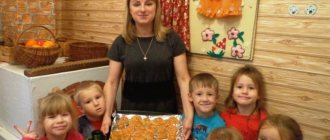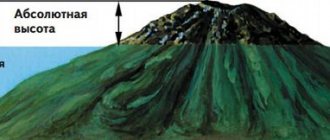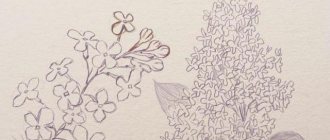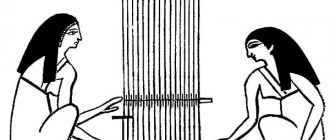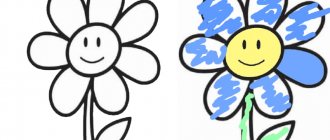Technology of collecting in children's educational activities
Venglevskaya N.V. Technology of collecting in children's educational activities // Sovushka. 2022. N2(12). URL: https://kssovushka.ru/zhurnal/12/ (access date: 02/05/2022).
Order No. 109182
In China they say:
“Whoever has a hobby,
lives two lives.”
Modern requirements imposed by the state on the quality of educational activities in kindergarten imply that the teacher must possess the necessary educational technologies.
Technology comes from the Greek words “craft, art” and “law, science” - it is the science of craftsmanship.
Pedagogical technology is a system of functioning of all components of the pedagogical process, built on a scientific basis, programmed in time and space and leading to the intended results (G.K. Selevko).
Throughout preschool childhood, along with play activities, cognitive activity is of great importance in the development of a child’s personality, which is understood not only as the process of acquiring knowledge, skills and abilities, but mainly as the search for knowledge, acquiring it independently or under the guidance of an adult. process of interaction and cooperation.
The development of cognitive interest contributes to the formation of a personal position in understanding the world around us, thereby ensuring readiness for school. Among the means of developing the cognitive interest of preschoolers, one can highlight collecting.
Collecting (from the Latin collection – gathering, gathering). is a systematic collection of homogeneous objects of scientific, artistic, and literary interest.
Collecting is one of the forms of non-traditional education for preschoolers. In the process of collecting, a process of accumulation of knowledge occurs, then the information received is systematized and a readiness to understand the world around us is formed. In the process of examining objects, preschoolers learn to solve intellectual problems and master the prerequisites for learning activities.
Today there are several most common types of collecting:
- kinoclephilia: collecting very small toys.
- legophilia: collecting toys and construction sets produced under the Lego brand.
- plangonology - collecting different dolls.
- phyllodia – collecting packages.
- philately - collecting postage stamps.
- bonistics - collecting various banknotes printed on paper.
- Numismatics – collecting various coins.
Plangonology - collecting dolls.
Kinderphilia - collecting figurines from kinder surprises. Usually, toys from a specific series become collectible objects in such cases.
Barbiphilia is a collection of Barbie dolls and everything connected with them - outfits, accessories, doll houses.
Not all authors of basic programs highlight collecting as a type of activity aimed at developing the cognitive interests of preschool children. Due to the fact that we are working under the Rainbow program, I would like to elaborate. The authors of this program, in order to form cognitive actions in children, develop consciousness, develop their interests, curiosity and cognitive motivation, recommend creating collections.
You need to start collecting with children in early preschool age. At this age, children begin to gather, which is the basis of collecting. With children of this age, the teacher creates treasures - wonderful bags or boxes. Together with parents, they make boxes or sew bags for each child, in which the child can store small objects in which there are no bright manifestations of the child’s individuality, but gender is visible (boys collect parts, springs, cars; girls - handkerchiefs, rags, hairpins) .
In middle preschool age, in jointly organized activities, children get acquainted with hand-made materials - fabric, paper, threads, and collections are created from samples, which will be supplemented in the process. Children, working with the collection, learn about the different properties of objects. Based on the ideas they receive, children formulate rules for handling things.
In older preschool age, with the development of individual cognitive interests, children's collecting begins to take on the form of collecting, that is, identifying, collecting, studying and systematizing objects of interest, repeatedly returning to what they have collected, admiring, examining, demonstrating to peers and parents.
Due to the fact that we work in a group for children of senior preschool age, our group has collected different collections, both ready-made, purchased in a store, and made together with children. The collections are freely available to children and are located in the experimentation center.
We have divided our collections into groups:
Collective - the teacher and children or children and parents take part in the creation of collections.
Individual - the child collects a collection on his own and, most often, the collection contains items of different purposes and uses.
Home collections are collections that a child collects at home with the help of his parents.
Temporary are collections collected on specific topics for a short time. Temporary collections include seasonal collections on the following topics:
“Golden Autumn”, “Gifts of the Snow Queen”, which helps children better remember the signs of the seasons.
Long lasting ones are collections of natural materials, paper, fabrics, candy wrappers, postcards - these are exhibits that can be touched and examined.
In jointly organized activities, collections were created:
Collection of buttons - in the process of creating this collection, children independently selected buttons by size, color, shape, material (iron, plastic, wood), and learned to sew them on.
Fabric collection – “Select according to sample”, “What is it made from...”.
Collection of paper machines – one day, while looking at the collection of machines we brought from home, we decided to create our own collection of paper machines. To do this, the boys learned to work with a drawing (which parts can be cut out and which cannot), in the process they solved problematic situations, but found a way out, for example, a part was cut off that needed to be glued, What to do?
Collection of postcards - we divided the postcards in our collection by topic: these are postcards for holidays (birthday, March 8, New Year). For the cognitive development of children, interesting series of postcards are fish, dogs, flowers, cities. We use these series both in direct educational activities and in joint activities. Speech games “describe”.
During direct educational activities with children, we got acquainted with the life and way of life of ancient people. When they looked at the wall paintings, the children became interested in why there was no paper at that time. And so we tried to answer the question of when, where and how paper appeared. In this regard, the research project “The Magic World of Paper” was developed.
The goal of this project is to create conditions for the development of preschool children through children’s ideas about paper and the possibilities of its use.
Tasks:
- Introduce the history of paper
- To form ideas about the types of paper, its properties, and its use by people.
- To instill in children the need to be careful with paper and about the limited resources in nature.
- Form the prerequisites for search activities.
The work was carried out in three stages:
At stage I, children learned when and where paper was invented, what they wrote on before paper was invented. At this stage, we had conversations with children, watched presentations, and looked for information in encyclopedias. They looked for information together with their parents, then the children shared the information with each other.
At stage II, we selected material for the collection (when the children learned that in ancient Rus' they wrote on birch bark, it appeared in our collection.) At this stage we studied the properties of paper.
Is the paper transparent?
The conclusion was drawn: the paper is opaque, the thicker the paper, the less light it transmits.
How durable is the paper?
Thin paper is easy to tear; the thicker the paper, the more difficult it is to tear.
Which type of paper will sink faster?
Conclusion: the thinner the paper, the faster it gets wet.
At this stage we decided to try to create a paper in a group.
In the third stage, we developed a collectible album.
The collections we have collected are used for working with students, not as an object stored on a shelf, we use it as a visual handout for conducting experiments, the objects serve as counting materials, in classes on speech development (each item in the collection is a new word for replenishing vocabulary , description of an object is the formation of coherent speech). When carrying out individual activities with each student.
To clarify the parents' position, individual interviews were conducted.
It turned out that many of the parents were involved in collecting in childhood. And some continue this activity now. Many families have a positive attitude towards collecting , encourage the child’s interest in collecting any objects, create a friendly atmosphere, provide assistance to the child (buy encyclopedias, coloring books, and decorate collection boxes together) .
During the creation and addition of collections, parents of students were active participants. To replenish the collections of buttons and fabric, they brought fabric and buttons. During the project, parents and children prepared reports about the history of paper creation. Parents took part in the design of the exhibition for their children, and also presented family collections.
Literature:
- Sample educational program "Rainbow".
- Grizik T.I. Cognitive development of children 2-8 years old: the natural world and the human world: method. manual for educators. M.: education, 2015. 218 p.
- Nikolaeva A.N., Popova L.V. Collecting as a means of developing the cognitive interests of children of senior preschool age // Concept. 2022. T.6. pp. 242-245.
- Collecting in kindergarten as a cultural practice. URL: https://podrastu.ru/doshkolnoe-obuchenie/formy/kolleksionirovanie-v-detskom-sadu.html.
- Features of collecting in childhood. URL: https://podrastu.ru/deyatelnost/detskoe-kolleksionirovanie.html.
Working with 5-6 year old children
Children can make crafts from natural materials in the older group.
Stock. To do this you need a sheet of white paper, a white square, colored pencils, glue with a brush, two small rowan brushes and scissors.- The teacher draws a silhouette of a girl or boy on a sheet of paper. The white square is folded in half and the corners are rounded off with scissors. It is smeared with glue and glued to the upper part of the figure, to the head area.
- The cuttings of maple leaves are shortened and the remainder of the cutting is smeared, capturing the leaf with glue.
- Next, the leaves are glued with the cuttings up onto the doll’s silhouette. It should be glued frequently so that the doll’s dress is fluffy and voluminous.
- Leaves cover the top of the white circle. This is doll hair.
- Rowan tassels should be glued to the sides of the head; they will indicate earrings.
- The kids will paint their faces as they wish. The eyes can be marked by gluing oblong green lilac leaves, narrowing them slightly.
In the same way, you can glue maple leaves onto a boy figurine.
What can children collect?
— Returning to children's collecting, we understand that toys are often a collecting item, not a collection. However, there are toys with history that were developed by famous artists and designers. For example: comic book heroes (why not have literary value?); miniature models of real cars of different years of production; dolls based on fairy tales or different professions, in outfits from different eras, different nationalities. Among them there are rare specimens designed for serious collectors, and their prices are appropriate. But circulation items are created for the mass public and they do not carry much value, and therefore are not considered collectibles. Often it is the latter that are offered to children. From a psychological point of view, is there a difference between collecting valuable and limited edition toys? Can such collections be considered useful and educational for children?
— For children there is not much of a difference. The value of things comes with experience. Therefore, if I were my parents, I wouldn’t splurge on expensive toys, unless, of course, they themselves want to build a collection of something.
You can first discuss with your child what he himself would like, and build on this. After all, if parents impose something, it doesn’t matter whether it’s collecting a rare collection or a popular one, the child’s interest in it may quickly disappear.
Whatever it costs. I believe that collecting collections is useful; I have already written about this above.
— Wouldn’t it be more useful for a child to collect, say, minerals or any other fossils, collect a herbarium, insects, children’s books based on famous works by famous illustrators, stamps in the end? After all, they all carry much more information, don’t you think?
- More useful - yes. But whether the child will be interested in this is another question. If it is important for parents that the collectible is useful, then they will have to use all their skills to lure the child into collecting a specific collection. These actions may include a joint search for exhibits, studying collectibles, reading literature and articles. But at the same time, measure is also important in this. If you concentrate only on finding exhibits or information about them, your child may quickly lose interest.
Does size matter?
“I always liked looking at other people’s collections, especially the grandiose ones. But at the same time, these grandiose collections, when they are not in museums, but in apartments, scare me. Sometimes it seems to me that such collecting absorbs people completely. Could this really be beneficial for the psyche, especially for children? Is there a difference between small collections and the phenomenon when a house turns into a museum?
— It all depends on the specific person who collects this or that collection. If the collection of items does not bother any of the other household members or pets, then that is his right. And if collection items, for example, block the passages between rooms, can fall off the shelves, if other things are thrown out that interfere with the placement of exhibits, or pose a danger to children, then this is already a problem. In this case, it can have an impact on children. When they see only one thing around (what is going on), their perception of the world as a whole narrows. If you add to this the obsession of collecting such things, it makes the situation worse. I can assume that children do not feel safe at home, not in terms of something physical, but in a psychological sense they remain unprotected when they see not the usual interior items around, but only the same collection items.
“Perhaps few parents will agree to expand their child’s collection to the size of his entire room. But I observe such a picture that when the interests of the child and the parent coincide, the collections become very voluminous, and quite a lot of money is spent on all new copies. How to grasp the edge of normality? How to tell yourself, and especially your child, that enough is enough?
“Everything, of course, depends on the person’s willpower to stop.” As a person who collects a collection at home, I can give one piece of advice. And he will be about restrictions. But first, let’s look at the process of how a person can be “dragged” into collecting exhibits for his collection. For example, a person collects rare books. If at first he can only collect books of a specific author or a specific focus (historical, about art), then over time this can absorb him so much that he will indiscriminately grab from trays and buy ALL rare books in used bookstores just for the sake of quantity. This requires considerable material investments, and a lot of space at home where he will have to place all this.
I have been collecting owls for more than 10 years. I don’t have many exhibits on my shelves, but they are all precious and beautiful to me. This collection has certain limitations. I collect figurines of owls from different countries and cities from 2 to 4 cm. You can’t find an owl of this size everywhere, and besides, will you like it if you find it? This is the value of each exhibit. I do not collect vases, posters, large figures, watches, or anything else with images of owls, but rather figures of a specific size. It looks very nice, doesn’t take up much space, and each figure is different in some way...
